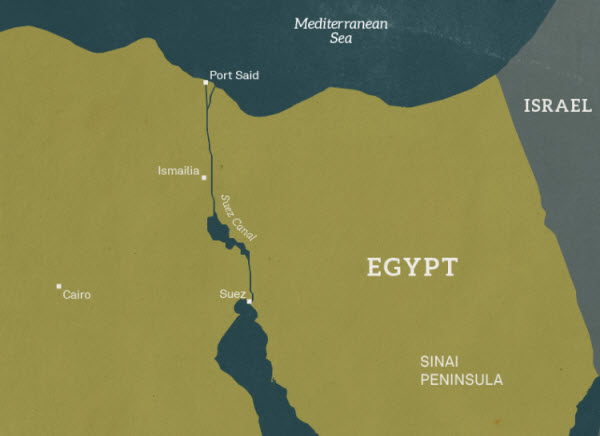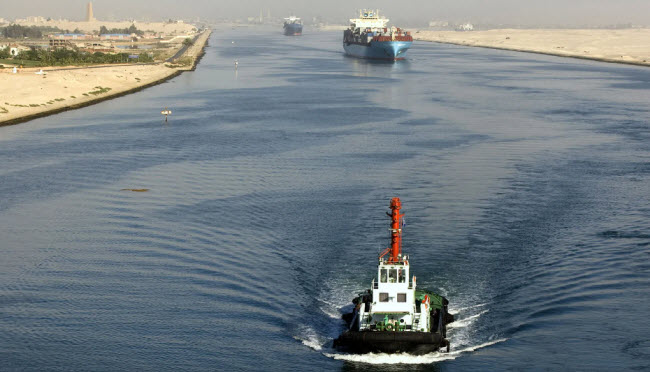The Suez Canal is an artificial waterway under Egyptian sovereignty, linking the Mediterranean Sea to the Indian Ocean via the Red Sea. Its significance lies in providing a direct route for shipping and trade between Europe and Asia, facilitating maritime traffic from the North Atlantic to the Indian Ocean without the need to navigate around Africa. This saves considerable time and money for shipping companies, making the Suez Canal a crucial conduit for international trade and strategically important to many nations. This importance has made it a focal point of international conflicts since its official opening in 1869, particularly during World War I, World War II, and the Arab-Israeli conflict.

The Suez Canal stretches 190 kilometers, beginning at the Mediterranean port city of Port Said in Egypt, passing through the city of Ismailia, and ending in the southern city of Suez on the northern shores of the Gulf of Suez. The canal separates the majority of Egyptian territory from the Sinai Peninsula. Construction took ten years, and the canal was officially opened on November 17, 1869. It is currently owned by the Egyptian state and managed by the Suez Canal Authority, with the goal of remaining open to ships from all over the world for both trade and military purposes.

History of the Suez Canal
The idea of a maritime route linking the Mediterranean Sea with the Red Sea dates back to ancient times. A series of small canals connected the Nile River, and consequently the Mediterranean Sea, to the Red Sea as early as 2000 BC. Centuries later, a direct connection between the two seas was considered impossible due to fears of differing sea levels. However, in the 1830s, the concept of a large canal providing a direct route between these water bodies was discussed. French explorer and engineer Ferdinand de Lesseps conducted a survey of the Isthmus of Suez and confirmed that the Mediterranean and Red Seas were at the same level, making canal construction feasible.
By the 1850s, Khedive Said Pasha of Egypt and Sudan saw the canal as a golden opportunity for Egypt. He granted French diplomat Ferdinand de Lesseps permission to establish a company to dig the canal, which eventually became known as the Suez Canal Company. The company was given a 99-year lease on the waterway and the surrounding area. De Lesseps initiated the first executive action by forming the International Committee for the Suez Canal, which included 13 experts from seven countries. Among them was Alois Negrelli, a leading civil engineer who effectively followed de Lesseps’ initial survey and played a key role in developing the canal’s architectural plans. The final report of the committee was completed in 1856, and two years later, the Suez Canal Company was officially established.

Construction of the canal began in early 1859 at the northern end of Port Said. The excavation took ten years, involving approximately 1.5 million workers, many of whom were laborers under harsh conditions. It is believed that tens of thousands died due to cholera and other causes. Political unrest in the region, including revolts against colonial rule and limited excavation technology of the time, led to significant cost overruns, with the total expense reaching $100 million, more than twice the original estimate.
On November 17, 1869, Khedive Ismail Pasha officially opened the Suez Canal. The first vessel to navigate the canal was the yacht “Eugénie,” of the Empress of France, followed by the British ocean liner “Delta.” However, the British naval ship HMS Newport was the first to enter the waterway, with its captain navigating into the canal under cover of darkness the night before the official opening. Captain George Nares was publicly reprimanded for this act but was secretly praised by the British government for his efforts to advance national interests in the region.

Initially, only steamships could navigate the canal, as sailing ships struggled with the narrow waterway during difficult winds. Although traffic was less than expected in the first two years of operation, the canal had a profound impact on global trade and played a key role in the European colonization of Africa. However, financial troubles led Ismail Pasha and others to sell their shares to Great Britain in 1875, though France remained the largest shareholder.
Wars and Conflicts
In 1888, the Constantinople Convention established the Suez Canal as a neutral zone under British protection, who subsequently took control of the surrounding region, including Egypt and Sudan. During World War I, the British defended the canal from an attack by the Ottoman Empire in 1915. The Anglo-Egyptian Treaty of 1936 confirmed British control over the canal, which became vital during World War II as Axis powers sought to seize it. Although neutral, Axis ships were barred from the canal for most of the war. In 1951, Egypt withdrew from the Anglo-Egyptian Treaty.
After years of negotiations, British forces withdrew from the canal in 1956, transferring control to the Egyptian government under President Gamal Abdel Nasser, who promptly nationalized the canal by transferring ownership to the Suez Canal Authority in July 1956. This move angered the United Kingdom, the United States, and France, particularly following Egypt’s outreach to the Soviet Union and the closure of the Strait of Tiran to Israeli ships. In response, British, French, and Israeli forces threatened to invade Egypt in what became known as the Suez Crisis or the Tripartite Aggression. To avoid escalating the conflict, Canadian Foreign Minister Lester B. Pearson proposed the creation of the first-ever United Nations peacekeeping force to protect the canal and ensure free navigation. The UN approved Pearson’s proposal on November 4, 1956.

Although the Suez Canal Company continued to operate the waterway, the UN peacekeeping force maintained access and peace in the nearby Sinai Peninsula. The canal’s central role in international conflict was not over. Tensions between Egypt and Israel flared again, leading President Nasser to order UN peacekeepers to leave the Sinai Peninsula. The Six-Day War of June 1967 resulted in Israeli forces capturing the eastern bank of the canal. Nasser imposed a blockade on maritime traffic, trapping 15 cargo ships in the canal for years until the October War of 1973, when Egyptian forces crossed the canal and took control of the eastern part of the waterway and areas deep into the Sinai Peninsula.
After the war, with international assurances, American and British mine sweepers cleared the canal, making it safe for navigation again. Egyptian President Anwar Sadat reopened it in 1975, leading a convoy of ships north to Port Said. Israeli forces remained in specific areas of the Sinai Peninsula until their complete withdrawal in the early 1980s as part of the 1979 Egyptian-Israeli Peace Treaty, which established a UN multi-national observer force that remains in place today.

The Suez Canal Today
Today, the Suez Canal sees an average of 50 ships transit daily, carrying over 300 million tons of cargo annually. In 2014, under President Abdel Fattah el-Sisi, Egypt oversaw an $8 billion expansion project that widened the canal from 61 meters to 312 meters and extended it by 37 kilometers. The project, completed in one year, allowed the canal to accommodate ships traveling in both directions simultaneously in part of its length.
Despite the expansion, in March 2021, a massive container ship from China became lodged in the canal, blocking the vital shipping route for over 100 ships on either side. This incident disrupted global trade for nearly a week, but the ship was eventually refloated thanks to significant efforts by the Suez Canal workers.
